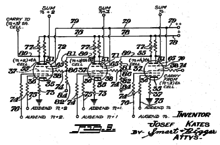大脑伯蒂
| 大脑伯蒂 | |
|---|---|
| |
 喜剧演员丹尼·凯耶刚战胜机器的照片 | |
| 类型 | 井字棋 |
| 平台 | 电脑 |
| 开发商 | 约瑟夫·凯特 |
| 模式 | 单人 |
| 发行日 | 1950年 |
《大脑伯蒂》[注 1](英语:Bertie the Brain,中国大陆又译作“伯蒂的大脑”[1])是约瑟夫·凯特为1950年多伦多加拿大国家展览会制作的早期电脑游戏,这是早期电子游戏史最初的游戏之一。展会出席者可用四米高的电脑,和人工智慧对弈井字棋。玩家用九宫布局的背光键盘走子,同时大屏幕上显示当前的棋局。机器可设难度等级。罗杰斯雄伟公司在两周展览后将其拆除,机器随好奇心过后被基本遗忘。
游戏是凯特展示其加法管(一种微型真空管)的工具。加法管限于专利,除游戏外再无实际应用;待专利不再为问题时,电脑已改用更先进的晶体管开发。《大脑伯蒂》或为最早运用视觉效果的游戏,可按某些定义称为最早的电子游戏。机器仅比阴极射线管娱乐装置(1947年造,已知最早的电子显示互动电动游戏)晚3年面世。游戏屏幕由电灯而非即时可视化屏幕显示,这种几无变化图形,不满足部分电子游戏的定义。
玩法
《大脑伯蒂》是一款井字棋游戏,玩家在斜竖起的九宫布局键盘行棋。机器的垂直大屏幕和键盘板上会同时显示局面,棋格会相应亮起X或O型的灯。机器会短暂思考后行棋。棋盘右方有一对交替亮起的指示标志,一组显示“Electronic Brain”(电脑)和X,一组显示“Human Brain”(人脑)和O;轮到玩家走棋时后者会亮起,玩家取胜的同时还会亮起“Win”。《大脑伯蒂》有多种难度设定[4]。电脑基本可以立刻做出回应,最高难度下玩家极难取胜[5]。
历史
《大脑伯蒂》是井字棋电脑游戏,由约瑟夫·凯特为1950年加拿大国家展览会制作[6]。凯特在二战期间,为罗杰斯雄伟公司设计并制作过雷达管。战后他在多伦多大学电脑中心读研究生,同时继续在罗杰斯雄伟公司就职[4]。期间他参与建立了多伦多大学电脑(UTEC)——全球最早的工作电脑之一。他还设计了微型真空管“加法管”(additron tube),该管于1951年3月20日在无线电电子装置制造商协会注册,编号6047[4][7][8][9]。
在真空管获得专利后,罗杰斯雄伟公司让凯特制作一台装置,向该管的潜在买主展示。凯特在公司工程师的协助下,以该技术制造了专用电脑[4][5]。这台四米高的大型金属电脑只能游玩井字棋,于1950年8月25日至9月9日在加拿大国家展览会间,在技术大楼装配展出[4][10]。
这台加法管电脑名为“大脑伯蒂”(Bertie the Brain),副标题为“罗杰斯雄伟公司的电子奇迹”(The Electronic Wonder by Rogers Majestic),在两周的展出中收获成功,与会者排队游玩机器。凯特尽量留在机器旁,为成人和儿童调整难度。《生活》杂志为(数度尝试后)取胜的喜剧演员丹尼·凯耶拍了照[4]。
影响

电脑在展后拆除,作为新奇品而被“基本遗忘”。凯特自称当时还有诸多项目,机器虽重要却无暇保存[4]。其虽为最早可实现的电脑游戏——之前只有理论上的棋类程序——且经《生活》杂志专题报道,但最后仍基本遭遗忘,甚至电子游戏历史书籍亦如此[5]。电脑主要用途为加法管宣传,但因该技术的成品应用只有游戏,故未能实现。在罗杰斯雄伟公司要凯特为展览开发工作模型时,他已耗时一年开发了多个版本的加法管,多伦多大学还认为开发进度过慢,想将之并入UTEC[11]。
虽有公司向凯特和罗杰斯雄伟公司表示,他们对加法管有兴趣,但他、公司和多伦多大学都受专利限制——该管在1955年前不得在加拿大外使用,而美国专利在申请6年后,到1957年3月才批准[11][12]。而那时更先进的电子管已经崛起,真空管的研发和应用大幅衰退,这类机器无力再兴[11]。凯特在加拿大工程领域成就卓越,但无意于真空管和电脑游戏[5][11]。
《大脑伯蒂》仅晚于阴极射线管娱乐装置——1947年发明,已知最早的电子显示互动电动游戏——三年面世;此外当时虽有阿兰·图灵的研究电脑,或迪特里希·普林茨在曼彻斯特大学费朗·蒂马克1上的象棋程序,但这些都是非视觉游戏,《大脑伯蒂》是最早运用视觉效果的电脑游戏[4][13][14]。《大脑伯蒂》在某些定义中是最早的电子游戏。按不同的定义,先前的阴极射线管娱乐装置为纯模拟电子游戏,而《大脑伯蒂》是无电子屏幕却运行于电脑上[15]。尼姆罗德是造于1951年的另一专用电脑游戏;克里斯托弗·斯特雷奇在1952年编写的井字棋游戏《OXO》和国际跳棋软件程序,是最早以电子屏幕而非电灯显示的电脑游戏[5][13][16]。
备注
参考文献
- ^ 黄石. 数字游戏设计史. 北京理工大学出版社. 2021: 12. ISBN 978-7-5682-9404-1 (中文(中国大陆)).
为了进行推广,约瑟夫·凯茨在加拿大的多伦多国家展览会上为该产品专门开发了一款名为“伯蒂的大脑”(Bertie the Brain)的游戏。
- ^ 利维坦©. 挑战爱因斯坦,只需10万个游戏玩家?. 虎嗅网. 2021-12-31 [2024-03-04]. (原始内容存档于2021-12-31) (中文(中国大陆)).
- ^ Ross, Edward. 電玩遊戲進化史【圖解漫畫版】:從桌遊、RPG、任天堂到VR,回味玩心設計大躍進的魅力指南. 由刘钧伦翻译. 台湾: 原点出版. 2023: 36. ISBN 978-626-7084-89-2 (中文(台湾)).
- ^ 4.0 4.1 4.2 4.3 4.4 4.5 4.6 4.7 Bateman, Chris. Meet Bertie the Brain, the world's first arcade game, built in Toronto. Spacing Magazine. 2014-08-13 [2014-11-16]. (原始内容存档于2015-12-22).
- ^ 5.0 5.1 5.2 5.3 5.4 Smith, Alexander. The Priesthood At Play: Computer Games in the 1950s. They Create Worlds. 2014-01-22 [2015-12-18]. (原始内容存档于2015-12-22).
- ^ Simmons, Marlene. Bertie the Brain programmer heads science council. Ottawa Citizen. 1975-10-09: 17 [2014-11-16]. (原始内容存档于2020-12-06).
- ^ Release #951. RTMA Engineering Department. 1951-03-20.
- ^ Sibley, L. Weird Tube of the Month: The 6047. Tube Collector (Tube Collectors Association). 2007, 9 (5): 20.
- ^ Osborne, C. S. The Additron: A Binary Full Adder in a Tube. Tube Collector (Tube Collectors Association). 2008, 10 (4): 12.
- ^ Varley, Frederick. F.H. Varley: Portraits Into the Light. Dundurn Press. 2007: 119. ISBN 978-1-55002-675-7.
- ^ 11.0 11.1 11.2 11.3 Vardalas, John N. The Computer Revolution in Canada: Building National Technological Competence. MIT Press. 2001: 31–33. ISBN 978-0-262-22064-4.
- ^ US patent 2784312,Kates, Josef,“Electronic Vacuum Tube”,发行于1957-03-05
- ^ 13.0 13.1 Kowert, Rachel; Quandt, Thorsten. The Video Game Debate: Unravelling the Physical, Social, and Psychological Effects of Video Games. Routledge. 2015-08-27: 3. ISBN 978-1-138-83163-6.
- ^ Donovan, Tristan. Replay: The History of Video Games. Yellow Ant. 2010-04-20: 1–9. ISBN 978-0-9565072-0-4.
- ^ Wolf, Mark J. P. Encyclopedia of Video Games: The Culture, Technology, and Art of Gaming. Greenwood Publishing Group. 2012-08-16: XV–7. ISBN 978-0-313-37936-9.
- ^ Hey, Tony; Pápay, Gyuri. The Computing Universe: A Journey through a Revolution. Cambridge University Press. 2014-11-30: 174. ISBN 978-0-521-15018-7.
| ||||||||||||||||||||||
Text is available under the CC BY-SA 4.0 license; additional terms may apply.
Images, videos and audio are available under their respective licenses.
